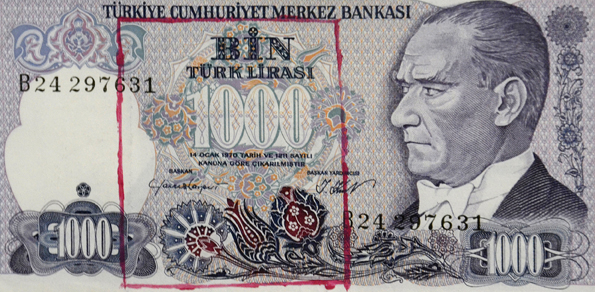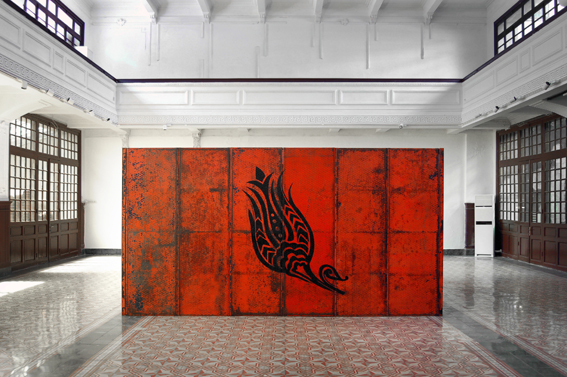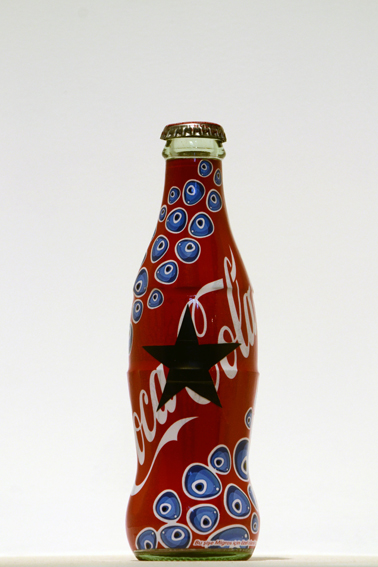The Italian artist Flavio Favelli (Florence, 1967) has been invited for the first time to exhibit (until June 14) in the Turkish main city, Istanbul. His solo exhibit (Grape Juice, curated by Vittorio Urbani) has been installed in the Main Hall of Galata Rum Okulo, the ancient Greek School in Galata (also one of the main venues of last edition of Istanbul Art Biennial, happened during the riots in Gezi Park).
The exhibit has been originated by a work and research in residence the artist experienced in the city thanks to the invitation of the International Program Anteprima (third edition), held by the Rome-based cultural association AlbumArte, chaired by Cristina Cobianchi and managed by Maria Rosa Sossai. His residence took place at Palazzo Venezia, this is the name of Italian Ambassador home in Turkey, Istanbul (the current Italian Ambassador is Mr Gianpaolo Scarante).
Favelli’s design has been starting from the brand of an old grape juice can. This juice has been produced in United States by Coca Cola Company and has been called Hi-C. The white star and the letter C printed on the label reminded Favelli of the Turkish flag. From this inspiration, the homonymous work, Grape Juice, has been created and gave the title to the entire show, consisting in four different exhibition modules. In the theatre-niche of Palazzo Venezia the artist placed what he called a “heart rending” object: a Coca Cola bottle he found in Italy that has been produced only for Turkey. An apparently simple and banal object that is containing multiple meanings and suggestions. Invited to represent Italy at the main world Art Biennial (Venice Art Biennale), the artist had also many other occasions to exhibit in important and international contexts. In Venice he exhibited a piece with strong national references but also with a ghost-like character. Referring to the crowd-funding activity the Italian Pavilion at Venice Biennale was facing at the time we were chatting about his Venetian exhibit, once he told me “it could be interesting to be sponsored by El Al, the Israeli air carrier. Israel is an infinite nation and with very strong issues. It is like the sand consuming the Western and Eastern tool, is the land of forecasts and of psychoneurosis of our times. And then, I love the logos of those airlines that have not changed notwithstanding the time passes.”
Carving, functional art, performance: which of these expressive means enables you to work on memory and above all on the social places – even before and more importantly than actual geographic places – you go through?
First I have to take all this discourse on a more personal ground, a more private dimension. You say I work on memory: that is a dense and heavy word. I want instead to say that I work on my personal memory. I rebuild my past because it is like a hole with no end, a universe shared in three parts: Hell, Purgatory, Paradise with a big elevator coming and going from these three floors. I am on this lift since I was born, before it has been my present tense and now, I am ascending and descending with my visions, and I still try to make it with my artworks. I do not find such a big difference among the three… disciplines you introduce. Sometimes I made an action into a piece of art that has been functional to my desire. Function in art is only assonant to wish and to a vision.
How many exhibits did you have until now? Could they be more than 40 including museums, galleries, fairs and biennials, workshop and residencies? Differently from many artists I have followed, you have a very personal touch either if you act in the main museums and galleries and during your lectures or in unconventional places for art. It seems to me you have an incredible passion for the audience….
In a recent presentation of my work in an Italian museum, the director asked me: “have you done too many things, too many shows?” I answered: the last artwork is always the best to me.Audience, to be sincere, does not exist for me, it is like a fake presence, a concept.
The art piece or the idea has to come out in a public realm even if there is no public. I produce a lot because I have lots of visions. One time I had a conference and a student asked me why in the ambient pictures I was showing there was always absence of audience. I answered that the question was a very good one and gave me the opportunity to understand this, because I’ve never noticed before. In short, my art is ideal even when I did the hall for the civil funerals at Monumental Cemetery (Bologna). This hall is ideal, its function is only an excuse to make it. It is like the Pharaohs Cemetery in the Old Egypt: things that are present there – as the tank, the bed, the private belongings – were not useful. It was more an issue about rituals, symbols, ideas.
You passed through fertile years and also you often passed through medias that normally other visual artists don’t touch, you nurtured yourself with what Bologna had to offer twenty years ago, from the social centre Link to the theatre. Could you please describe what you do more today than yesterday to feed your omnivorous curiosity, since you have decided to settle in a little village nell’ Appennino (Italian mountains)? Outside of your studio, which are the places where you oftengo??
I’ve been living on the Appennino for 13 years now, and I can tell you that I do not miss the city. When I approached art I discovered the rhythm and serial joy to work, activity that I love more than any other thing. I do not watch TV; I have not gone to the movies for more than 10 years now; I only work. Working means that, beside making the pieces with my hands, I read, write and draw. I am writing a lot and one day I will love to publish something relating my art and the art of others. I do not have any peculiar destination, on summertime I travel to search things, objects. In these years I took lots of things. I clearly remember a ceramic found in Caltagirone, some Crystal beer cans picked up in Havana and some coins for subway bars in Delhi. All in all, my destinations are the objects I’ve found somewhere. Lately there is a great conspiracy against objects arisen by art critics. Public art and relational art now are the mastering divisions. Objects stay still, unknowable, deadpan, as Mario Trevi says: they linger, they can be handed down.
Your art is serving for site-specific pieces and, I am convinced, also for a certain love, to do not say the morbidity, of collectors, because you challenge the nature itself of collection: your creativity is shaking and mixing as a house mix, so it breaks the specific shape of the object by letting it be something else.
What are collectors specifically looking from you and on what do you think in the near future, especially for the next Venetian shows, to revise your language? Which space will you leave to colour, rather than to form?
Today I find it difficult to meet a free collector and as you say a ‘morbid’ collector. On their top priorities there is money, accounting, the business. The real morbidity is their eye on their wallet. I have to say that my series Archivio (the pad frame with a black glass mosaics) is very fortunate, as well as the stamps collages and the chocolate envelops. With just a few exceptions, normally nobody asks anything about the meaning of the piece and its ultimate motivation. Everything is superficial, everything is like betting. More than on colour and form, I would say that I will rely on the sole area meaning something for me: psyche.
…I often noted that the artwork content exercises on me a stronger attraction than their formal and technical qualities. (S. Freud, The Moses of Michelangelo, 1914). The same happens to me.









